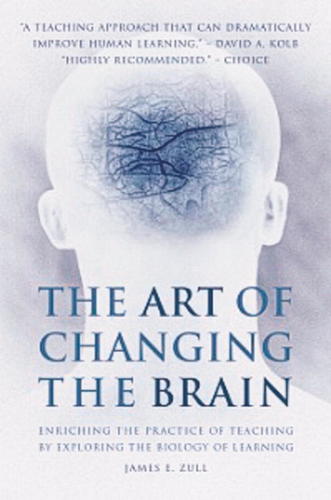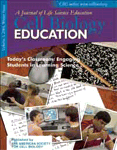The Biological Justification for Transforming our Teaching

“Learning is about biology.” James Zull's first sentence sums up his thesis in The Art of Changing the Brain. Dr. Zull proposes that recent and continuing advances in neuroscience should inform the practice of teaching. After all, learning is an activity of the brain, so shouldn't we be teaching with an underlying understanding of how the brain works? Writing for educators at all levels, Zull lays out a simple but convincing relationship between Kolb's learning cycle and the anatomy of the human cerebral cortex. Understanding how information flows into and between various parts of the brain helps us to understand how to structure our courses to improve student learning. The practical suggestions and stories from his Zull's own classroom experiences make this book useful, and his engaging and humorous writing style make it a pleasure to read. As I progressed through the book, I kept finding biological reasons why certain things that I do in my classroom work well, and why, regardless of my effort, other things don't work as well as I had hoped.
The opening chapter reminds us that “learning is physical,” meaning that learning involves physical changes in the brain. The remainder of the book is divided into three meaty sections making the case in detail, followed by a short epilogue to summarize. Part I lays out brain anatomy for novices, focusing on the cerebral cortex. The anatomy and physiology are purposefully oversimplified so that the text is comprehensible even to non-science teachers. However, ample references are included at the end of each chapter for those who want more details. Zull draws a compelling picture by overlaying Kolb's learning cycle onto specific areas of the brain cortex, correlating Kolb's activities of experience, reflection, abstraction, and active testing to the sensory cortex, temporal integrative cortex, frontal integrative cortex, and motor cortex, respectively. True learning requires activation of all four areas of the cortex; therefore, good teaching will ensure that students use all four areas. For example, learning that consists only of memorizing and regurgitating facts fails to activate the frontal integrative area. The teachers among us will easily recognize this situation. How many of us have complained that our students could memorize large amounts of information, but were unable to use that information in a new scenario or application? When I taught genetics as a straight lecture course, I ended up with many “genetic historians” but few geneticists. After switching to a more problem-based style of teaching that encourages the use of the frontal integrative cortex, I was pleased by the change in outcome. Now the majority of students can propose a reasonable series of genetics experiments to explore or understand a new observation or situation.
Although his description of neuroanatomy starts out superficially, Dr. Zull introduces more complexity as he delves deeper into his subject. I was fascinated by another intriguing idea developed in Chapters 4 and 5, in which he discusses motivation and emotion in evolutionary terms. Although I have often wondered about some students' motivations (or lack thereof), I must admit to paying little attention to emotions in learning, other than attempting to have a friendly, nonthreatening classroom environment. Zull draws connections between learning, which evolved as a survival mechanism, and the fear and pleasure centers of the limbic system, which biochemically make us want to do things that favor survival. For example, he cites studies showing that activity in the amygdala decreases during puzzle solving, suggesting that negative emotions are lessened when students are actively engaged in their work. Additionally, the hippocampus appears in a chapter on memory storage and the effects of emotions and stress. The relationships between the limbic system and the cerebral cortex explain what anyone who has earned a Ph.D. knows: that intrinsic rewards (pleasure, reduction of fear, and sense of control) are much more powerful that extrinsic rewards (grades). Therefore understanding how the brain manages motivation enables us to help students discover and use their own natural motivators.
In Part II, titled “Knowledge, Neuronal Networks, Change, and Recommendations for the Teacher,” Zull suggests specific ways in which we can help our students learn (i.e., change their brains). Here we find a description of neurons and “neuronal networks,” a term he favors over “neural networks.” We are reminded that neuronal networks are changed over time, experience, or both by strengthening or inhibiting synapses. From this perspective, our job as educators is to help students effect such material changes in their own neuronal networks. One key point in this section is that prior knowledge or “understanding” exists physically as neuronal networks; therefore, it is persistent and cannot be ignored by teachers. How many of us have struggled against students' misconceptions learned in the past? I have lost count of how many time I have pointed out that interphase is not a stage of mitosis, but that old high school memory of “stages of mitosis = IPMAT” is nearly impossible to dislodge! Because we cannot get rid of incorrect prior knowledge, we have to figure out ways to use it to make and strengthen new correct networks.
Because Parts I and II convinced me that my teaching can be improved by keeping this biological context in mind, I was eager for the concrete suggestions in Part III, “Using More of the Cerebral Cortex for Learning.” Replete with examples from Zull's and others' experiences, this section focuses on how teachers can activate specific functions of the cerebral cortex. For example, providing rich sensory input maximizes the use of the sensory cortex. In this arena, science teachers have the advantage of laboratory classes for using multiple senses to input new information. Or, when working on initial integration, it is important to know the difference between having a mental picture of something and having language to describe it; these are handled by different parts of the brain. (How many easy genetics questions have been missed because students failed to first transform the written problem into a simple diagram showing the relative locations of the markers on chromosomes?) The bottom line, as described in the last chapter titled “We Did This Ourselves,” is that students will change their own brains if we give them appropriate stimuli and support.
James Zull does a masterful job at bringing neuroscience to bear on the learning process. Not surprisingly, brain biology is consistent with discoveries in educational research about the value of collaborative learning and other “new” teaching methodologies. However, for those of us who became biologists first and teachers second, it is reassuring to know that the changes we make in our classrooms are actually grounded in anatomy and physiology.



